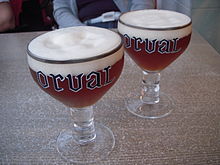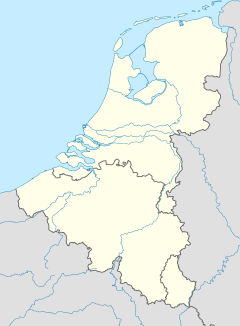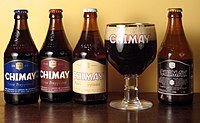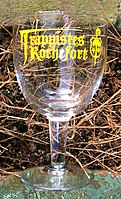Trappist beer

Trappist beer is brewed by Trappist monks. Thirteen Trappist monasteries—six in Belgium, two in the Netherlands, and one each in Austria, Italy, England, France, and Spain— produce beer,[1] but the Authentic Trappist Product label is assigned by the International Trappist Association (ITA) to just ten breweries which meet their strict criteria. As of 2021[update], Achel is no longer recognized as a Trappist brewery because it does not have any monks.[2]
History
The Catholic Trappist order originated in the
Monastery brewhouses, from different religious orders, have existed across Europe since the
In 1997, eight Trappist abbeys – six from Belgium (
- The beer must be brewed within the walls of a Trappist monastery, either by the monks themselves or under their supervision.
- The brewery must be of secondary importance within the monastery and it should witness to the business practices proper to a monastic way of life.
- The brewery is not intended to be a profit-making venture. The income covers the living expenses of the monks and the maintenance of the buildings and grounds. Whatever remains is donated to charity for social work and to help persons in need.
The German Trappist abbey of Mariawald has not produced beer since 1953, however it is a founding member of the Trappist Association and uses the same Authentic Trappist Product logo for its other products.[citation needed]
As of January 2021, Belgium has only 5 Trappist beers (ATP) left since Achel lost its ATP designation due to the last monk leaving the Order. However, its Trappist beer (not ATP) production is still ongoing and has been taken over by Westmalle.[4] In 2012, Belgian Post honored the Trappist breweries in the country with a commemorative collection of stamps.[5] As of 25 January 2023, Achel lost its designation as a Trappist beer due to selling the abbey to a private person.
In the twentieth century, the growing popularity of Trappist beers led some brewers with no connection to the order to label their beers "Trappist". After unsuccessful negotiations, monks sued one such brewer in 1962 in Ghent, Belgium.[citation needed]
The Dutch brewery De Koningshoeven produces Trappist beers – branded La Trappe – that are able to carry the "Authentic Trappist Product" logo. Their use of the International Trappist Association logo was withdrawn in 1999, but was restored in October 2005 (see
An expansion of ITA recognized breweries took place for the first time in 2012 when the trappist brewery of the abbey of Engelszell, Trappistenbrauerei Engelszell in Engelhartszell, Austria started brewing beer at the monastery (the former production had stopped in 1929) and in the same year obtained the Authentic Trappist Product logo for their beer.[6]
In December 2013, Maria Toevlucht's abbey (Zundert, the Netherlands) and St. Joseph's Abbey (Spencer, Massachusetts, United States) were both granted the ATP recognition for their Trappist beers, followed in 2015 by Tre Fontane Abbey brewery in Rome.[citation needed]
In June 2018, the monks of

International Trappist Association recognised breweries
As of January 2022, fourteen Trappist monasteries that are members of the ITA have beers named after them — six in Belgium, two in the Netherlands, and one each in Austria, Italy, England, France, Spain and the United States.[9]
Authentic Trappist Product label
In addition to being a Trappist brewery, the monastic communities that are members of the ITA can apply for the Authentic Trappist Product (ATP) label.[10] The following criteria are used for ATP label:[11]
- All products must be made within the immediate surroundings of the abbey;
- Production must be carried out under the supervision of the monks or nuns;
- Profits should be intended for the needs of the monastic community, for purposes of solidarity within the Trappist Order, or for development projects and charitable works.
List of Trappist breweries
There are currently thirteen breweries producing Trappist beer.[9] Ten of them (with the exception of Achel, Mont des Cats, whose beer is not brewed at their monastery but at Chimay,[12] and Cardeña from the Abbey of San Pedro de Cardeña, whose beer is currently produced off-site[13]) are allowed to display the Authentic Trappist Product logo on their beer products.[11] In January 2021, "Achel" of the St. Benedict's Abbey in Hamont-Achel lost the Authentic Trappist Product label, as the brewing process was no longer supervised by monks on site, but the beer remains a Trappist beer, as the Saint Benedict Abbey falls under the Westmalle Abbey and the abbot of Westmalle Abbey visits the Achelse Kluis every week and supervises the brewing and other activities in the Achelse Kluis.[14] In January 2023, the abbey was sold to a private person. From that day on, "Achel" lost the recognition as a Trappist beer. [15] In May 2022, St. Joseph's Abbey ceased beer production.[16] In May 2023, Stift Engelszell published an article about dissolution of the monastery and move all monks to other monasteries.
| Brewery | Location | Opened | Annual production (2004) |
|---|---|---|---|
| Brouwerij der Trappisten van Westmalle | 1836 | 120,000 hL (100,000 US bbl )
| |
| Brouwerij Westvleteren (St Sixtus) | 1838 | 4,750 hL (4,050 US bbl) | |
| Bières de Chimay | 1863 | 123,000 hL (105,000 US bbl) | |
Brouwerij de Koningshoeven (La Trappe) |
1884 | 145,000 hL (124,000 US bbl) | |
| Brasserie de Rochefort | 1899 | 18,000 hL (15,000 US bbl) | |
| Brasserie d'Orval | 1931 | 71,000 hL (61,000 US bbl) | |
| Stift Engelszell | 2012 | 2,000 hL (1,700 US bbl) | |
St. Joseph's Abbey in Spencer, Massachusetts Closed in 2022 |
2013 (closed 2022) | 4,694 hL (4,000 US bbl) | |
Brouwerij Abdij Maria Toevlucht (Zundert) |
2013 | 5,000 hL (4,300 US bbl) | |
| Tre Fontane Abbey | 2015 | 2,000 hL (1,700 US bbl) | |
| Mount St Bernard Abbey (Tynt Meadow) | 2018 | 2,000 hL (1,700 US bbl) | |
| Mont des Cats (not ATP) | 1826 | N/A (not ATP) | |
| Cerveza Cardeña Trappist (not ATP) | 2016 | N/A (not ATP) | |
| Achel Abbey Recognition as Trappist beer lost in 2023 (abbey sold to a private individual) | 1850 | N/A (not ATP) |
Belgium breweries
Brasserie de Rochefort
Trappist Abbey of Westmalle
St. Sixtus Abbey of Westvleteren
Bières de Chimay
Brasserie d'Orval
De Achelse Kluis






